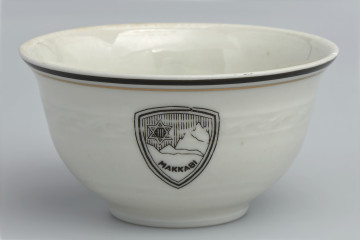Pesach cup
1918 — 1939
Museum of the history of Polish Jews
Part of the collection: Ritual goblets and mugs in the collection of the Polin Museum
A Pesach mug in the form of a small tankard, made of transparent glass. On the entire surface of the belly, convex glass scales are visible, facing upwards, resembling those which can be found in spruce cones or fish. The handle, attached below the middle of the belly height, is small, rather thin.The mug comes from the collection of memorabilia of Edward Rajber (b. 2 April 1910 in Rzeszów, d. 10 March 1984 in Warsaw), an activist of the Polish Jewish community. In his youth, he belonged to the KPP (Communist Party of Poland) and the Communist Union of Polish Youth. He fought in the September campaign. Still in 1939, he managed to escape to the USSR, where he worked in a coal mine. During his stay in the USSR, he became involved in activities aimed at supporting his compatriots on behalf of the Union of Polish Patriots. In 1946, he was repatriated to Poland. He started working in a textile factory in Dzierżoniów (until 1946, Rychbach) in Lower Silesia.
In the first post-war years, Dzierżoniów became a strong centre of Jewish settlement. The first Jews to settle in Lower Silesia were the survivors of the Gross-Rosen concentration camp and its branches (https://sztetl.org.pl/en/glossary/gross-rosen). The Provincial Jewish Committee in Lower Silesia (WKŻ), established in June 1945 in Dzierżoniów, quickly organised a large-scale campaign to settle Jews in these areas. About 86,500 people (mainly repatriates from the USSR, such as Edward Rajber) were settled there in less than a year. The area of Lower Silesia, recently reclaimed from the Third Reich and assigned to Poland, became the place of residence of the largest Jewish community in post-war Poland. Dzierżoniów was then sometimes referred to as “Żydków” (“the Jewish Town”): in November 1946, the number of Jews in the town reached 17,800 people (see https://sztetl.org.pl/en/towns/d/212-dzierzoniow/99-history/137273-history-of-community). Dzierżoniów was the centre of Jewish life in the Recovered Territories until the transfer of the seat of the WKŻ to Wrocław in April 1946. The establishment of the state of Israel (1948) and political changes in Poland resulted in a rapid emigration of the Jewish population. As early as 1950, the number of Jews in Dzierżoniów decreased to 28% of that of 1946.
During the years spent in Dzierżoniów, Edward Rajber was active in the PPR (Polish Workers’ Party) and PZPR (Polish United Workers’ Party). He was the First Secretary of the City and County Committee of the Polish United Workers’ Party in Dzierżoniów (1947–1956). In 1962, he was elected the secretary of the Social and Cultural Society of Jews in Poland, which involved the necessity to move to Warsaw. He mainly dealt with matters concerning Jewish children and youth; he organised holiday camps and discussion groups. In the years 1968–1984, he was the president of the Society. He is buried at the Jewish cemetery in Warsaw at Okopowa St.
The mug, along with an extensive archive, was donated to the POLIN Museum by Hanna Mistowska-Rajber.
Marta Frączkiewicz
Author / creator
Dimensions
cały obiekt: height: 4,4 cm, width: 6 cm
Object type
vessel (container)
Technique
blowing into shape
Material
glass
Creation time / dating
Creation / finding place
Owner
POLIN Museum of the History of Polish Jews
Identification number
Location / status
1918 — 1939
Museum of the history of Polish Jews

1930 — 1939
Museum of the history of Polish Jews
non ante 1894
Museum of the history of Polish Jews
DISCOVER this TOPIC
National Museum in Szczecin
DISCOVER this PATH
Educational path